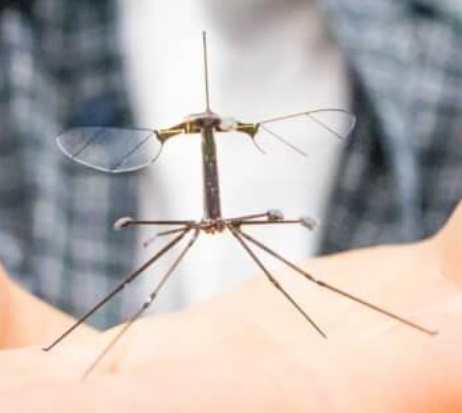| Harvard RoboBee Gets New Knees |
| Written by Lucy Black |
| Friday, 25 April 2025 |
|
The Harvard RoboBee can now make better landings thanks to new legs based on those of a crane-fly. The researchers who developed the robot say it now no longer needs to crash land, and can instead glide down under control. RoboBee is a robot inspired by bees. It flies by flapping its wings which are powered by artificial muscles. Its wingspan is less than 3 cm and it weighs around 0.10 grams. Current versions are mainly connected by wires to a power source and a microprocessor, though there is also a solar powered version.
RoboBee has been under development since the early 2000s, with the first successful flight announced in 2007. The eventual aim is a fully autonomous swarm of Robobees that could be used for surveillance, search and rescue, or even artificial pollination of crops. Until now a major problem for the RoboBee has been landing. It can fly, dive, and hover like a real insect, but its small size and light weight have made landing difficult. The Harvard team, led by Robert Wood, the Harry Lewis and Marlyn McGrath Professor of Engineering and Applied Sciences in the John A. Paulson School of Engineering and Applied Sciences (SEAS), has now added a set of long, jointed legs inspired by those of the crane fly. The robot's controller has also been improved to add the ability to decelerate as the bee comes down to land. The team says this addition should protect the robot's flight muscles - actually piezoelectric actuators - as these are easily fractured by rough landings. Coming close to the ground while flapping its wings caused instability because of the air movements caused by the flapping. Christian Chan, a graduate student who led the mechanical redesign of the robot, said: "Previously, if we were to go in for a landing, we'd turn off the vehicle a little bit above the ground and just drop it, and pray that it will land upright and safely." A paper published by the team in Science Robotics describes improvements to the robot's controller so it adapts to the ground effects as it approaches. One of the lead authors of the paper, former postdoctoral researcher Nak-seung Patrick Hyun, who led controlled landing tests on a leaf as well as rigid surfaces, said: "The successful landing of any flying vehicle relies on minimizing the velocity as it approaches the surface before impact and dissipating energy quickly after the impact. Even with the tiny wing flaps of RoboBee, the ground effect is non-negligible when flying close to the surface, and things can get worse after the impact as it bounces and tumbles." The researchers considered a number of flying insects as possible models for their leg upgrade for RoboBee, and eventually chose the crane fly because the size and scale of RoboBee's wingspan and body size is fairly similar to that of crane flies. Crane flies have long, jointed legs that act as dampers when they are landing. The lab used manufacturing methods pioneered in the Harvard Microrobotics Lab for adapting the stiffness and damping of each joint. The current version of the RoboBee is still tethered to off-board control systems, but the team is working on scaling up the vehicle and incorporating onboard electronics to give the robot sensor, power, and control autonomy. The National Science Foundation Graduate Research Fellowship Program supported this research.
More InformationRoboBee Article In Science Robotics Related ArticlesControlling 5,000 Autonomous Drones Improving Stability In Flapping Wing Robots Festo's BionicSwifts Fly Like Real Birds To be informed about new articles on I Programmer, sign up for our weekly newsletter, subscribe to the RSS feed and follow us on Twitter, Facebook or Linkedin.
Comments
or email your comment to: comments@i-programmer.info |


